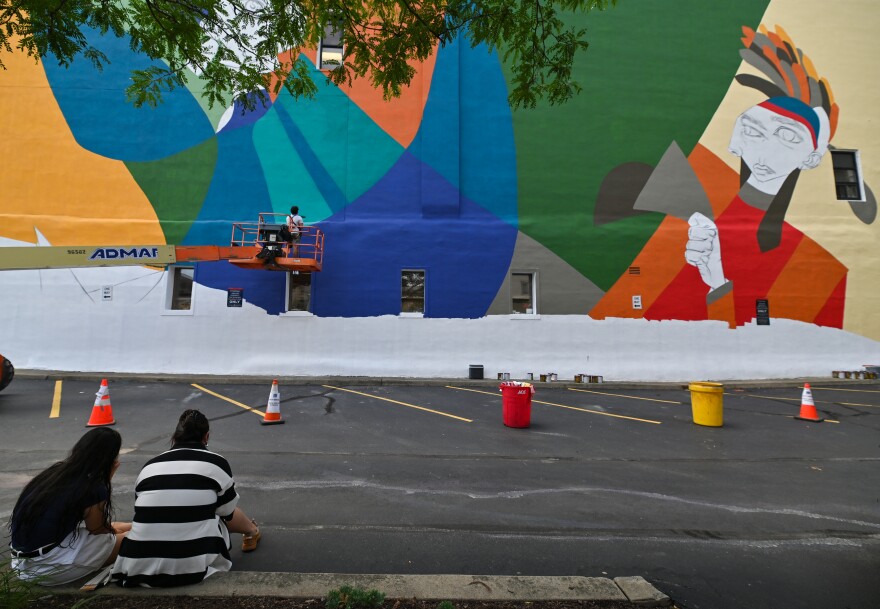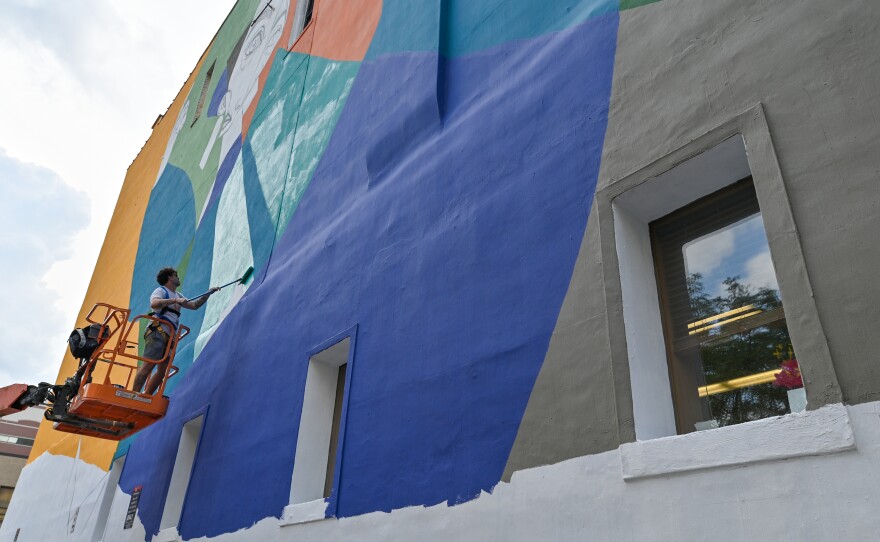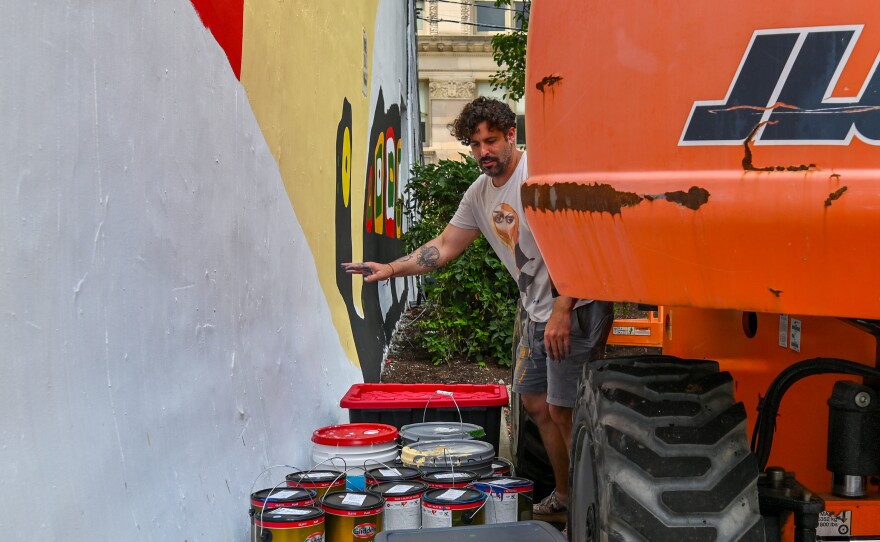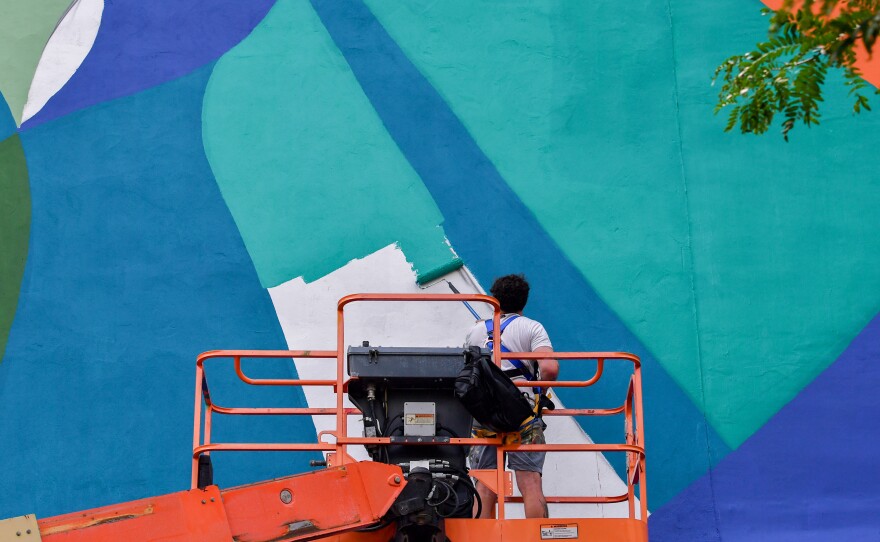Lenape artist Ben Miller spent years trying to figure out who his people were artistically.
"We're from the East Coast originally, but we've been moved so many times that we've crossed other tribes, and we have adopted some of their designs and patterns. I really wanted to reach home and figure out what we wanted, so I researched,” he said.
Known as the grandfather tribe, the Indigenous people were the first to live in the region and along the Delaware River, he said.
Miller is a citizen of the federally recognized Delaware Tribe of Indians, which includes the Lenape people. He came home this month with that research to paint his second mural — a large work of art on 8,000 square feet on the side of the Brixx Building on North Washington Avenue in downtown Scranton. Miller and his friend and mentor, Miguel Angel Belinchón, known as Belin, painted the mural together.
"Here I am now back at home in Lackawanna and Scranton being able to put up some energy for my people, about my people, with one of the best artists I've ever met in my life,” said Miller.
In his research on Lenape art, he found the Ojibwe. They are native people of the Northeastern Woodlands.
"And Ojibwe, they focus on woodland arts, and … that's what hit me. We're not Plains like Lakota, or we're not Dene or a Navajo style. We have woodland patterns that we've kept for many, many years, and that's the patterns that I'm putting up, the floral patterns,” he said.
'We all danced'
The wall is painted in earth tones — dark green, burnt orange and a pale yellow that looks like a field in the fall.
Miller and Belin painted two dancers wearing regalia. Belin has an almost-Picasso style to the realistic faces he created using spray paint. The texture is so real that it looks like a photograph. The male dancer’s brown eyes are the largest part of his face. His nose is off to the side. He’s wearing red and orange, while the female dancer with a similar unsymmetrical face is in dark blues and turquoise.
"No matter where you're from in the world, anywhere from a geisha, from Japanese, to the Greek to the Italians, the Mexicans, we all had one thing in common, that was dance. We all danced. We all had a traditional dance that we did to bring our societies together,” Miller said.
In the bottom right-hand corner, Miller painted a black turtle with a big yellow eye and a patterned shell. The reptile represents his clan name and the Lenape's creation story.
"Tens of thousands of years ago, we believe that what is now the United States, or Northern America, was built on a tortoise's back, a turtle's back, and … a big bird came and dropped dirt right on top of the tortoises, that’s where all the plants grew from it. And this is where we began,” he said.
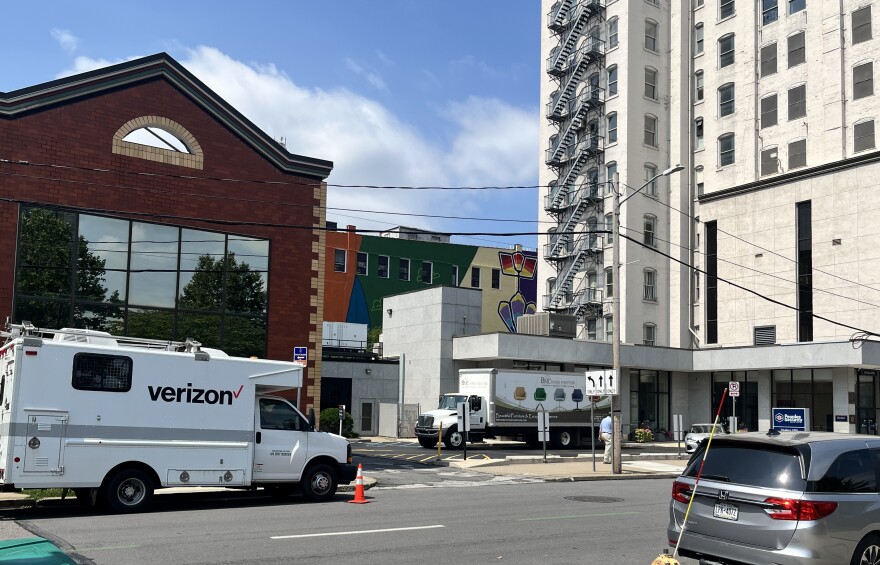
Lenapehoking, where the project began
In 2021, the University of Scranton received a grant from the National Endowment for the Humanities. Through that grant, the school focused on the area’s indigenous history. Curtis Zunigha came to speak. He cofounded the Lenape Center in New York.
"It was that project where afterwards we're like ‘wow, our community really doesn't know a lot about the Lenape or Delaware history that was here’ and they were the original people," said Maureen McGuigan, Lackawanna County's director of arts and culture. "People were really curious. It's just traditionally, there really hasn't been a lot of information there.”
The Lenape's historical territory included northeast Delaware, New Jersey, northeast Pennsylvania and areas in New York. The indigenous people called their ancestral homeland Lenapehoking.
McGuigan said, at the county and within the arts community, they asked themselves, what can we do?
"What resources do we have to build this relationship to basically reconnect the Lenape to their homeland,” she said.
Through her position, McGuigan said they have found that murals are a great way to engage with the community in a creative and inspiring way.
Two years ago, they began looking for a Lenape artist to paint a mural. Zunigha recommended Miller.
The tribe had total control over the design. But with the large size of the wall, the county knew Miller needed a partner. So, he brought in Belin from Spain.
"So then it became this global project,” said McGuigan.
It also became a local project.
The Lackawanna County Arts and Culture Department, through the county’s arts and culture tax, Lackawanna County’s visitors bureau, the Scranton Area Foundation, the Greater Scranton Chamber of Commerce and the university all helped fund the mural.
“We are hoping that this is the first of many projects, even if they're just yearly, you know, reconnecting people and educating,” she said.
But McGuigan's already seen a change.
"There's more awareness, even just in the short time,” she said.
Building bridges
Miller said the Lenape were the first tribe to sign a treaty with the United States government.
“Treaty of Fort Pitt, which offered us a seat in Congress and our own state, would be the 14th colony,” he said. “As we are in 2025, it didn't work out that well. But that's when you put politics into it. When you take the politics out of it, humanity, we work well together,” he said.
After the treaty was reneged on, the Delaware peoples found their way to Ohio, then Indiana. They ended up in Kansas and finally in Oklahoma. He said some went to Canada and others went to Texas.
For Miller, who lives in Florida, he said the East Coast is missing its indigenous identity. He was drawn to the project for the chance to connect with his homeland.
"It's more than just a mural to me; it's not a job. I get to come home and I get to see the names and the words that we use and connect," he said. "And I felt that it's a great opportunity to bring identity back to the Delaware people.”
For people who walk past the mural or stop to take it in, Miller hopes it answers the question of who the Lenape are.
"And that we are still here, we're still alive, and that we have future opportunities," he said. "Instead of building walls, we would like to build bridges.”
Miller was clear-coating the finished mural last week.
An unveiling will be held during Scranton’s First Friday at 5 p.m. on Aug. 1. The event will feature Latino music and food, to honor Belin, and indigenous treats by Old Man John’s Coffee and Honey House in Luzerne and speakers from the tribe.

